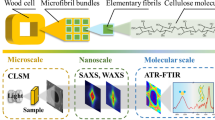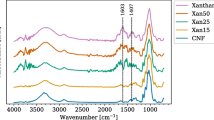Abstract
The penetration of water- and solventborne binders into the capillaries of wood was studied as a function of the viscosity, surface tension, and capillary pressure according to the Washburn equation.
During the penetration, water is selectively removed from the coating, which causes a strong increase in viscosity that limits the penetration. Waterborne dispersions and emulsions showed a rapid increase in viscosity with increasing solid matter content. Surface tension of the binder and the adsorption of surfactants to the wood have an additional influence on the maximum penetration.
Similar content being viewed by others
References
Meijer, M. de, Thurich, K., and Militz, H., “Comparative Study on Penetration Characteristics of Modern Wood Coatings,”Wood Sci. Technol., 32, 347–365 (1998).
Scheikl, M. and Dunky, M., “Measurement of Dynamic and Static Contact Angles on Wood for the Determination of Its Surface Tension and the Penetration of Liquids into the Wood Surface,”Holzforschung, 52, 89–94 (1998).
Militz, H. and Peek, R-D., “Möglichkeiten der Verbesserung einiger Eigenschaften von Pappelnholz durch Tränken mit wasserlöslichen Harzen,”Material und Organismen, 28, 55–73 (1993/94).
Banks, W.B., “Water Uptake by Scots Pine Sapwood, and Its Restriction by the Use of Water Repellents,”Wood Sci. Technol., 7, 271–284 (1971).
Loon, J. van, “The Interactions Between Paint and Surface,”J. Oil & Colour Chemists’ Assoc., 49 (10), 844–867 (1966).
Rødsrud, G. and Sutcliff, E.J., “Alkyd Emulsions-Properties and Application. Results From Comparative Investigations of Penetration and Aging of Alkyds, Alkyd Emulsions, and Acrylic Dispersions,”Surf. Coat. Int., 77 (1), 7–16 (1994).
Nussbaum, R.M., Sutcliffe, E.J., and Hellgren, A.C., “Microautoradiographic Studies of the Penetration of Alkyd, Alkyd Emulsion, and Linseed Oil Coatings into Wood,”Journal of Coatings Technology, 70, No. 878, 49 (1998).
Nussbaum, R.M., “Penetration of Waterborne Alkyd Emulsions and Solventborne Alkyds into Wood,”Holz als Roh- und Werkstoff, 52, 389–393 (1994).
Dulien, F.A.L., El-Sayed, M.S., and Batra, V.K., “Rate of Capillary Rise in Porous Media with Nonuniform Pores,”J. Colloid Interface Sci., 60 (3), 498–506 (1977).
Marmur, A., “Capillary Rise and Hysteresis in Periodic Porous Media,”J. Colloid Interface Sci., 129 (1), 278–285 (1989).
Denesuk, M., Smith, G.L., Zelinski, B.J.J., Kreidl, N.J., and Uhlmann, D.R., “Capillary Penetration of Liquid Droplets into Porous Materials,”J. Colloid Interface Sci., 158, 114–120 (1993).
Borhan, A. and Rungta, K.K., “An Experimental Study of the Radial Penetration of Liquids in Thin Porous Substrates,”J. Colloid Interface Sci., 158, 403–411 (1993).
Washburn, E.W., “The Dynamics of Capillary Flow,”Physical Review, 17, 273–283 (1921).
Tollenaar, D., “Capillarity and Wetting in Paper Structures: Properties of Porous Systems,” In:Surfaces and Coatings Related to Paper and Wood, 1st ed., Marchessault, R.H. and Skaar, C. (Eds.), Syracuse University Press, Syracuse, NY, pp. 196–197 (1967).
Fengel, D. and Grosser, D., “Holz, Morphologie und Eigenschaften,” In:Ullmanns Encylopädie der Technischen Chemie, 4th Ed., Vol. 12, Verlag Chemie, Weinheim, pp. 669–679, 1976.
Stamm, A.J., “Passage of Liquids, Vapors, etc. through Softwoods,”U.S. Dept. Agr. Technical Bulletin, No. 929 (1946).
Rijckaert, V., Acker, J. van, Stevens, M., Meijer, M. de, and Militz, H., “Quantitative Analysis of the Penetration of Waterborne Primers into Wood by Means of Fluorescence Microscopy,” inAdvances in Exterior Wood Coatings and CEN-Standardization, Proc. of PRA-Conference Brussels, paper 19, 1998.
Meijer, M. de, Militz, H., and Thurich, K., “Surface Interactions Between Low VOC Coatings and Wooden Substrates,”Proc. 23rd FATIPEC Congress Brussels, Volume C, 191–214, 1996.
Kerr, A.J. and Goring, D.A.I., “The Role of Hemicellulose in the Delignification of Wood,”Can. J. Chem., 53 (6), 952–959 (1975).
Tarkow, H., Feist, W.C., and Southerland, C.F., “Interaction of Wood with Polymeric Materials, Penetration Versus Molecular Size,”For. Prod. J., 16 (10), 61–65, (1966).
Coté, W.A. and Robison, R.G., “A Comparative Study of Wood,”Journal of Paint Technology,40, No. 525, 427 (1968).
Schneider, M.H., “Scanning Electron Microscope Study of a Coating Component Deposited from Solution into Wood,”J. Oil & Colour Chemists’ Assoc., 62, 441–444, (1979).
Schneider, M.H. and Sharp, A.R., “A Model for the Uptake of Linseed Oil by Wood,”Journal of Coatings Technology,54, No. 693, 91–96 (1982).
Vanderhoff, J.W., Bradford, E.B., and Carrington, W.K., “The Transport of Water Through Latex Films,”J. Polym. Sci., 41, 155–174 (1973).
Croll, S.G., “Drying of Latex Paint,”Journal of Coatings Technology,58, No. 734, 41 (1986).
Croll, S.G., “Heat and Mass Transfer in Latex Paints During Drying,”Journal of Coatings Technology,59, No. 751, 81 (1987).
Eckersley, S.T. and Rudin, A., “Drying Behaviour of Acrylic Latexes,”Prog. Org. Coat., 23, 384–402 (1994).
Sherman, P., “Rheological Properties of Emulsions,” inEncyclopedia of Emulsion Technology, Vol. 1, Becher, P. (Ed.), Marcel Dekker, New York, pp. 403–437, 1983.
Mooney, M.,J. Colloid Sci., 6, 162 (1951).
Dougherty, T.J. and Krieger, I.,Adv. Colloid Interface Sci., 3, 111 (1972).
Frankel, N.A. and Acrivos, A.,Chem. Eng. Sci., 22, 847 (1967).
Janssen, J.W., Blom, C., and Mellema, J., “The Flow Curves of Latex Dispersions with Added Thickener,” (In Dutch),Verfkroniek 61 (6), 254–258 (1988).
Janssen, J.W., Blom, C., and Mellema, J., “The Flow Curves of Latex Dispersions with Added Pigment and Thickener,” (In Dutch),Verfkroniek, 62 (7/8) (1989) 283–293.
Kissling, R.L. and Gross, P.H., “Capillary Behaviour of Viscous Liquids,”J. Phys. Chem., 74 (2), 318–326 (1970).
Dillon, P.W., “Application of Critical Relative Humidity, an Evaporation Analog of Azeotropy, to the Drying of Waterborne Coatings,”Journal of Coatings Technology,49, No. 634, 38 (1977).
Löfflath, F., Gebhard, M., “Rheological Changes During the Drying of a Waterborne Latex Coating,”Journal of Coatings Technology,69, No. 867, 55 (1997).
Meijer, M. de, Thurich, K., and Militz, H., “Quantitative Measurements of Capillary Coating Penetration in Relation to Wood and Coating Properties,”Wood Sci. Technol., in press.
Beetsma, J., “Alkyd Paints: From the Ease of Organic Solvents to the Difficulties of Water,”22nd FATIPEC Conference Budapest Vol. 2, 157–167, 1994.
Patton, T.C.,Paint Flow and Pigment Dispersion: A Rheological Approach to Coating and Ink Technology, 2nd ed. John Wiley and Sons, New York, p. 99, 1979.
Siau, J.F.,Transport Processes in Wood. Springer, Berlin, p. 29, 1984.
Deng, Y. and Abazeri, M., “Contact Angle Measurement of Wood Fibers in Surfactant and Polymer Solutions,”Wood Fiber Sci., 30 (2) 155–164 (1998).
Author information
Authors and Affiliations
Additional information
P.O. Box 497, NL-6700 AL Wageningen, The Netherlands
Rights and permissions
About this article
Cite this article
de Meijer, M., van de Velde, B. & Militz, H. Rheological approach to the capillary penetration of coating into wood. Journal of Coatings Technology 73, 39–51 (2001). https://doi.org/10.1007/BF02698437
Issue Date:
DOI: https://doi.org/10.1007/BF02698437




